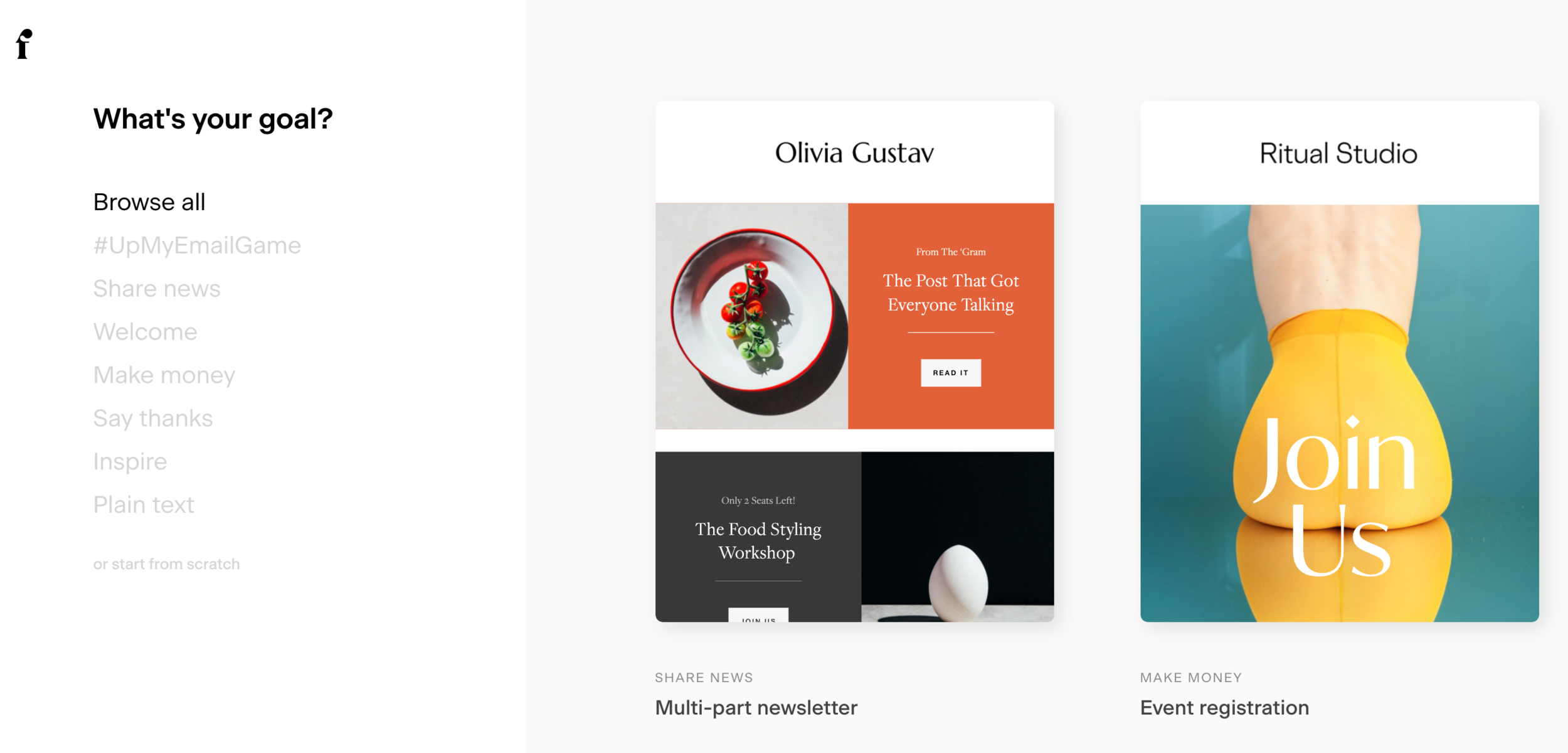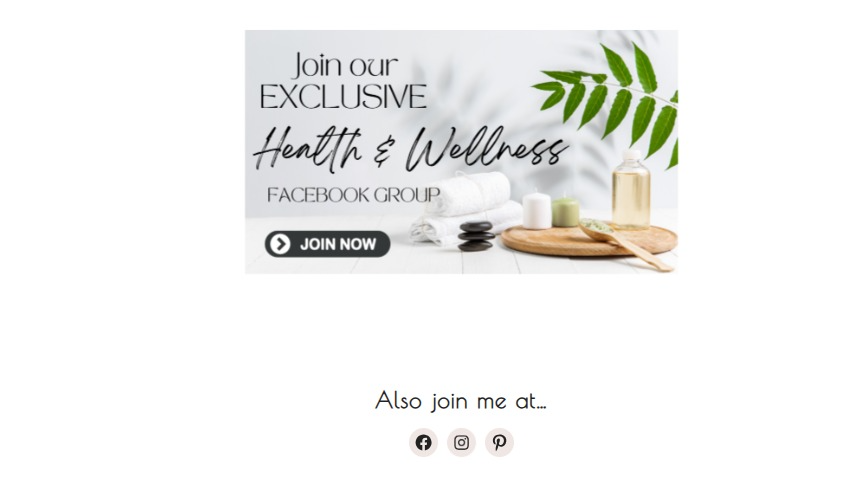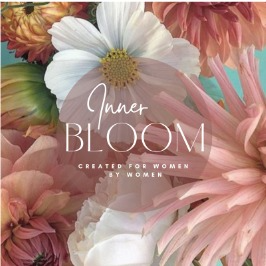
Email marketing! That term is simultaneously exciting (if you know it’s one of the key ways to grow your online wellness business) and dreadful (if you have no idea where to begin with it 😰).
I’ve mentioned this lots before: email marketing is arguably the most important “following” you can achieve in your health coaching business.
Unlike social media platforms, which change their algorithms all the time (affecting how many of your followers even see the content you share), you “own” and always have access to your business’ email list.
This makes it the most reliable channel for staying in touch with your audience, sharing new wellness content with them, keeping them informed about your health coaching offerings, and promoting any special launches or offers they should know about.
Your email list is especially important if you sell digital wellness products (think e-books, resource libraries or video archives, etc.), or if you’re interested in developing those types of products down the road—it’s a key audience to whom you’ll market and sell those offerings. We offer the Inner Bloom MRR and it includes all the digital products you need at one low price…grab yours here
But, in health coaching and other wellness professions, it’s also important to build and nurture an email list for your direct services as well (1:1 coaching, group wellness classes, etc.). Health coaching is such a personal service that it really requires nurturing a relationship and building rapport with potential clients before trying to offer them expensive coaching packages.
So, as a health coach, you definitely need an email list. But… how to get started, and what to do with it?
what’s the best email marketing tool for health coaches?
While there are many great email marketing tools available to choose from, there are only one that I recommend most often to health coaches and wellness professionals:

- It’s, hands-down, the simplest, cleanest and easiest-to-use email marketing tool out there. Its dashboard is super minimalist, contains all it needs (and nothing more!), which makes it really easy to navigate and efficient to use.
- It’s affordable and the pricing is simple. Unlike other tools that charge per subscriber or email send, which increases your pricing over time (though Mailchimp starts off free, it does get expensive as your list grows), Flodesk has just one pricing plan that gives you unlimited subscribers and email sends—so the price doesn’t continue to increase forever and ever in the future. (And, right now, you can get 50% off your Flodesk subscription—and lock in that pricing not just the first month or year, but forever!!)
- Flodesk’s email templates are super gorgeous, and you have the ability to use custom fonts (and even script handwriting fonts!), which is hard to come by in email marketing.
- It’s really easy to set up and use workflow automations—things like your welcome automation or opt-in funnels—to keep your list engaged.
- The Flodesk sign-up forms allow you to collect an email address and first and/or last name.
Once you’ve chosen your email platform, connected it to your website opt-ins, and set up your welcome automation, it’s time to draft a template for your wellness newsletter!
Why you need a regular email newsletter in your health coaching business
Sending regular, quality communication to your email list helps to keep them informed and engaged with your health coaching business and the content you create.
For example, your email newsletter can help to:
- provide educational wellness content relevant to your audience’s health needs and goals
- establish yourself as an industry expert
- share important updates about your health coaching services or products
- provide examples of relevant content your audience will enjoy or may have missed (such as previous popular blog posts)
- share reminders about your coaching services, who they’re a good fit for, and how to access them
- let your readers know how to get in touch with you or engage in additional ways if they’re interested
- further establish your brand personality
- share special offers exclusive to your list
And the list goes on! Your newsletter is an opportunity to incorporate whichever of these strategies is beneficial for your particular health coaching needs and goals.
Whichever newsletter strategies make best sense for you, and whichever email marketing platform you choose, you can apply the same principles outlined below for structuring your wellness newsletter.
We’ll walk through specific instructions to set up your email newsletter in both Mailchimp and Flodesk:
HOW TO SET UP YOUR HEALTH COACH EMAIL NEWSLETTER
First of all, there is no one “right” or “wrong” way to structure your email newsletter. Totally have some fun with it! Share your personality, share content of value to your audience… and don’t be afraid to do what feels natural and good for you. 😎
Also, don’t worry about trying to please everyone! It’s most efficient and impactful to write directly to your target health coaching audience. Those are the people who want to be on your list because they find the content you share to be useful and valuable. If people aren’t into it, they can leave—that’s totally fine!
Create your health coach newsletter template
To create consistency across your emails (and reduce duplicating your work down the road!), it’s best to set up a specific “Newsletter” template you’ll work from for future newsletters.
creating a health coach newsletter template in flodesk
In Flodesk, head to Emails > New Email and select a template that works for your needs.

Here’s what I recommend customizing & including in your health coach newsletter template:
1. your logo or photo
Of course, you’ll want to add your logo (if you have one) to your email marketing!
In Flodesk:
In Flodesk, you can actually add your logo directly to your Flodesk account and it will auto-populate into the logo block in any of their email templates. To add your logo, just head to Account > Branding > Logo and upload your logo. It’s best to use a transparent .png image so it will look great on any background you end up using!
2. your brand colors
Most email marketing tools allow you to stylize your emails to match your overall business branding, and one way to do that is to incorporate your brand colors.
There are a few key places to add your brand colors throughout your email template:
Links: We like to keep our links stylized in a brand color.
- In Flodesk, update this under your email template’s Global style > Link color.
Buttons:
- In Flodesk, click on a button and update Fill color and Border color in the style editor on the right side of your screen.
Headings: You may choose to stylize your heading fonts in a brand color.
- In Flodesk, simply highlight the text you’d like to style and update the Font color in the style editor on the right side of your screen.
flodesk brand colors
In Flodesk, you can add your brand colors so they’re easily accessible for use throughout your email template and forms. Add your specific brand color codes via Account > Branding > Brand colors. Then, you can apply the brand color throughout your emails with just the click of a button, as they’ll always appear in your color editor.
Add your brand colors to the Flodesk color editor:

3. an intro message
For most of your email newsletters, you’ll want to include some type of intro message. This could be a bold header about the content below, a blurb with updates or important information, or a personal message from you.
Your email newsletters can be crafted the voice of your business/brand, or from you personally. For health coaches and wellness professionals, particularly if your primary business offering is 1:1 services, it’s typically best to send them from you—as you are the face of your brand.
4. imagery
Though there are varying opinions on the pros/cons of using images in email marketing, the wellness industry is a particularly important place for compelling imagery—so we say, use it!
But, a note on using images in your email newsletters:
There are a few drawbacks to using lots of images in your email marketing:
- Image-heavy emails may take longer to load.
- Some email clients (or email settings) block images from downloading automatically, which can result in your emails not displaying as they should.
- Some email clients may be more likely to flag image-heavy emails as “marketing” or “spam” (meaning they could end up in the dreaded Promotions folder in Gmail).
In general, it’s best to not rely too heavily on images in your email newsletters—they can certainly be used to support and enhance your message, but they shouldn’t be your entire message.
5. call-to-action
While your email newsletter may be full of awesome content and opportunities to take action (great!), it’s best to highlight and emphasize just one call-to-action you’re encouraging your readers to take.
There are many different ways to share your call-to-action, though most involve links—in the form of a button, a linked image, text links, etc.
Here, my email uses both a text link and a button to send readers to our blog:
6. links to relevant content
Your regular email newsletter will typically serve as an avenue for sharing fresh content with your audience. Often, this means promoting and sharing links to specific blog content.
Whether you write a wellness blog or not (though I definitely recommend you do, and here’s why!), find ways to share relevant content with your email subscribers—so they know that when they open an email newsletter from you, they’ll receive new and interesting information relevant to their wellness interests.
7. how to contact you
Email marketing is not just a one-way street of sending content to your audience. It’s also helpful to let your subscribers know how to contact you.
If you’re available to field questions your readers have (whether about your health coaching services or your wellness content), it’s great to let them know that.
You can allow subscribers to reply directly to you by hitting “reply” on your newsletter. If you’d like to encourage this, simply include a little message in your newsletter template that lets people know this is an option. (And, ensure that your newsletter “reply to” email address is set to the account you’ll be checking for these messages!)
Here’s an example message we’ve included in our email newsletters, letting subscribers know they can hit “Reply” and we’ll see it and answer:
8. social buttons
If you have a social media presence for your health coaching business, it’s also a good idea to include social links in your email newsletter.
If your primary call-to-action is to send readers to these links, you’ll want to call them out in other ways as well, but in general, they’re just “helpful to have, here if you need them” resources for your readers. They’re most often placed at the bottom of your newsletter template, either in the footer or directly above the footer.

The only platform we’re really active on is Pinterest (which is technically not social media, and is one of the top marketing strategies I recommend for health coaches)… but including just the Pinterest button looks a little lonely so we added our wellness group too. 😄
9. footer
Though most of your email newsletter template is a blank slate you can do with as you’d like, there are a few essential elements to include in your email newsletter footer to ensure you’re complying with the CAN-SPAM Act. (Unlike its name suggests, this means you can’t spam people—it’s a law to prevent unsolicited email marketing.)
Here are the elements you must include in your email newsletter footer:
- Your business mailing address
- A link to unsubscribe or update email preferences
Note that any content with merge tags will look a little crazy on the back-end, but will appear normally on live emails. Here you can see how our footer looks in the back-end vs. how it will appear in emails:
In Flodesk:
Flodesk will automatically populate your footer with your business mailing address and an unsubscribe link.
You have the option to choose from several pre-written unsubscribe messages, which are pretty cute:
And, you’re welcome to add other content to your footer as well. I like adding copyright information and a note reminding subscribers why they’re receiving the email (or how they signed up). It can also be helpful to clarify that if they unsubscribe, they will be removed from all emails from you, including any waiting lists or program communication they’ve signed up for.
10. subject line
Your subject line is one of the most important elements of your email newsletters, because it influences whether subscribers will actually open your email and read its contents.
When crafting your newsletter subject line, choose a message that is:
- descriptive of your email content
- uses keywords of interest to your readers
- uses an element of surprise or curiosity
- evokes the emotion/feeling you’d like readers to have
Here are the important pieces of information you’ll need to provide about each of your email newsletters:
- Email subject: You want your subject line to be descriptive of your email content, and compelling enough that subscribers will want to open it—but not so descriptive that it gives away all the juicy details of your email. It’s a good idea to keep your subject line under 9 words.
- Preview text: This is the “preview text” that displays in your subscriber’s inbox before they open an email. Generally you’ll just copy/paste the first sentence or two of your email content, though you could write something else too if that makes more sense.
- From name: This will be the sender name displayed to your subscribers. Choose something your audience will recognize, like your name or your company name. Some people choose to personalize their message with a from name such as “Melissa from Four Wellness Co.” that includes both your name and the company name.
- From email address: This is the email address your message will be sent from, so choose something that makes sense for the email’s purpose. As a health coach or other wellness professional, you’ll usually want your emails to come from you directly—so it’d be better to use an email address like [email protected] rather than [email protected].
Test your email before sending
As you finish up your template, it’s a good idea to send a live test to yourself to confirm that everything is appearing as it should. Be sure to check the message on both desktop and mobile!
In Flodesk, just click the Test button (paper airplane) at the top left of your email editor. You can also always preview your email on desktop or mobile via the corresponding buttons at the top right of your email editor:
Those are all the key things to include in your branded email newsletter template for your health coaching audience. Happy emailing 🙂

